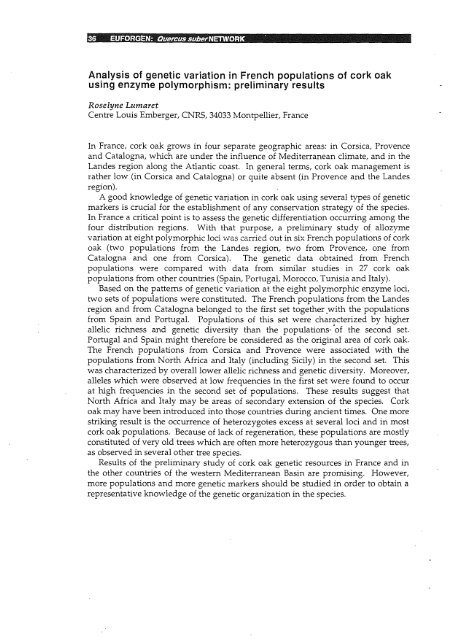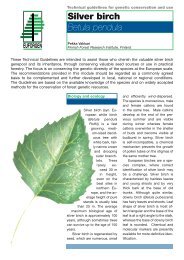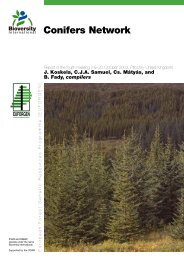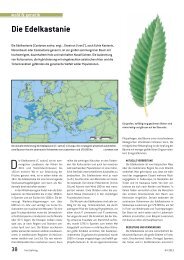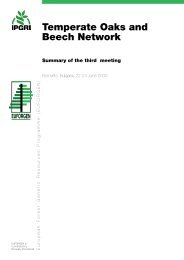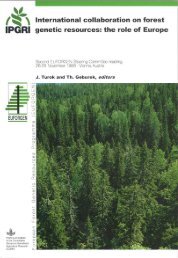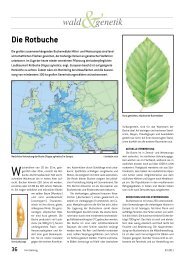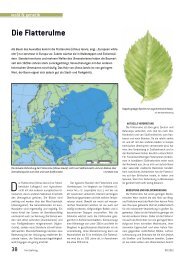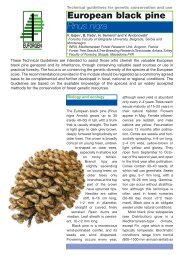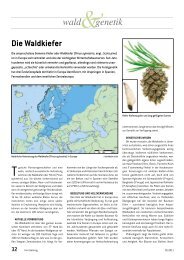Download PDF - Euforgen
Download PDF - Euforgen
Download PDF - Euforgen
Create successful ePaper yourself
Turn your PDF publications into a flip-book with our unique Google optimized e-Paper software.
36 EUEORG!:N: Quercus subeICNE1"WORK 'Analysis of genetic variation in French populations of cork oakusing enzyme polymorphism: preliminary resultsRose lyne LumaretCentre Louis Emberger, CNRS, 34033 Montpellier, FranceIn France, cork oak grows in four separate geographic areas: in Corsica, Provenceand Catalogna, which are under the influence of Mediterranean climate, and in theLandes region along the Atlantic coast. In general terms, cork oak management israther low (in Corsica and Catalogna) or quite absent (in Provence and the Landesregion).A good knowledge of genetic variation in cork oak using several types of geneticmarkers is crucial for the establishment of any conservation strategy of the species.In France a critical pOint is to assess the genetic differentiation occurring among thefour distribution regions. With that purpose, a preliminary study of allozymevariation at eight polymorphic loci "Nas carried out in six French populations of corkoak (two populations from the Landes region, two from Provence, one fromCatalogna and one from Corsica). The genetic data obtained from Frenchpopulations were compared with data from similar studies in 27 cork oakpopulations from other countries (Spain, Portugal, Morocco, Tunisia and Italy).Based on the patterns of genetic variation at the eight polymorphic enzyme loci,two sets of populations were constituted. The French populations from the Landesregion and from Catalogna belonged to the first set together _with the populationsfrom Spain and Portugal. Populations of this set were characterized by higherallelic ridmess and genetic diversity than the populations> 'of the second set.Portugal and Spain might therefore be considered as the original area of cork oak.The French populations from Corsica and Provence were associated with thepopulations from North Africa and Italy (including Sicily) in the second set. Thiswas characterized by overall lower allelic richness and genetic diversity. Moreover,alleles which were observed at low frequencies in the first set were found to occurat high frequencies in the second set of populations. These results suggest thatNorth Africa and Italy may be areas of secondary extension of the species. Corkoak may have been introduced into those countries during ancient times. One morestriking result is the occurrence of heterozygotes excess at several loci and in mostcork oak populations. Because of lack of regeneration, these populations are mostlyconstituted of very old trees which are often more heterozygous than younger trees,as observed in several other tree species.Results of the preliminary study of cork oak genetic resources in France and inthe other countries of the western Mediterranean Basin are promising. However,more populations and more genetic markers should be studied in order to obtain arepresentative knowledge of the genetic organization in the species.


